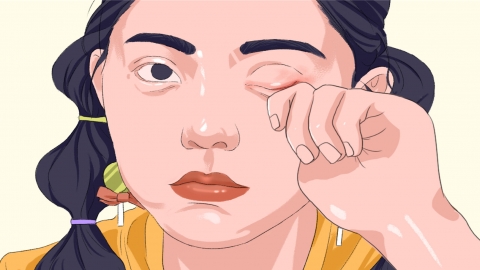What causes a stye?
Stye generally refers to hordeolum, which may be caused by excessive eye use, poor eye hygiene, decreased immunity, seborrheic dermatitis, diabetes, and other factors. Management should be based on individual situations. It is recommended to visit a hospital promptly and follow medical advice for treatment.

1. Excessive Eye Use: Prolonged use of electronic devices or reading can cause eye fatigue, dysfunction of the meibomian gland secretion, and blockage of gland ducts, making one prone to hordeolum. Common symptoms include dryness and soreness in the eyes. It is important to use your eyes reasonably, take regular breaks, rest for 5-10 minutes every hour, look into the distance or close your eyes to relax, and apply warm compresses to the eyes.
2. Poor Eye Hygiene: Rubbing the eyes with hands or using unclean eye cosmetics can introduce pathogens such as bacteria into the eyelid glands, causing inflammation. Symptoms include redness, swelling, and painful nodules in the eye area. It is important to develop good hygiene habits, wash hands frequently, avoid rubbing the eyes, choose reputable eye cosmetics, ensure thorough makeup removal, and maintain eye cleanliness.
3. Decreased Immunity: Long-term熬夜, overexertion, malnutrition, and other factors can reduce the body's immunity, weakening the eyes' ability to resist bacteria and increasing susceptibility to hordeolum infection. It is recommended to maintain regular作息, ensure sufficient sleep, eat a balanced diet, and engage in moderate exercise to improve physical fitness.
4. Seborrheic Dermatitis: Excessive sebaceous gland secretion and excessive oil on the skin surface can affect the eyelids, blocking the openings of the meibomian glands and causing hordeolum. Symptoms include redness, swelling, and flaking at the eyelid margins, accompanied by itching. Patients can use medications such as tacrolimus ointment, pimecrolimus cream, and compound ketoconazole shampoo under a doctor's guidance to alleviate symptoms.
5. Diabetes: Patients with diabetes often have elevated blood sugar levels over a long period, which affects immune function and makes it easier for bacteria to multiply in the eyes, causing hordeolum. In addition to symptoms of hordeolum, patients may also experience polydipsia, polyphagia, polyuria, and weight loss. It is recommended to follow medical advice to use medications such as insulin injection, metformin tablets, and gliclazide modified-release tablets to promote recovery.
In daily life, it is important to remove eye makeup promptly after using cosmetics and avoid using expired products. Maintaining good eye hygiene helps promote eye recovery.
References:
[1] Liu Xuyu. Analysis of the Characteristics and Influencing Factors of Traditional Chinese Medicine Constitution and Syndrome Types in Recurrent Hordeolum [D]. Chengdu University of Traditional Chinese Medicine, 2024.
[2] Li Chaoyan. Clinical Observation of the Efficacy of Babao Eye Ointment in Treating Stye (Acute Hordeolum) [D]. Beijing University of Traditional Chinese Medicine, 2022.




